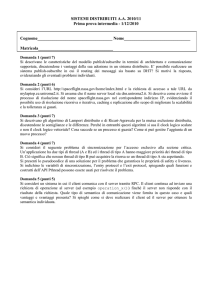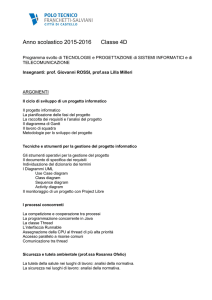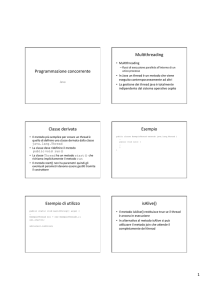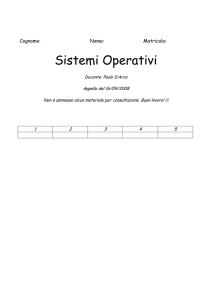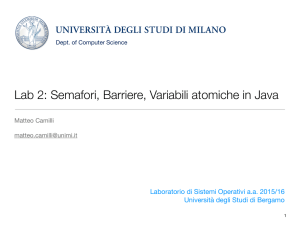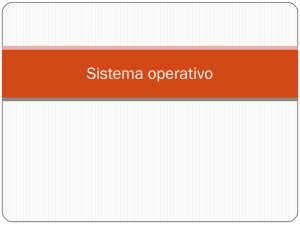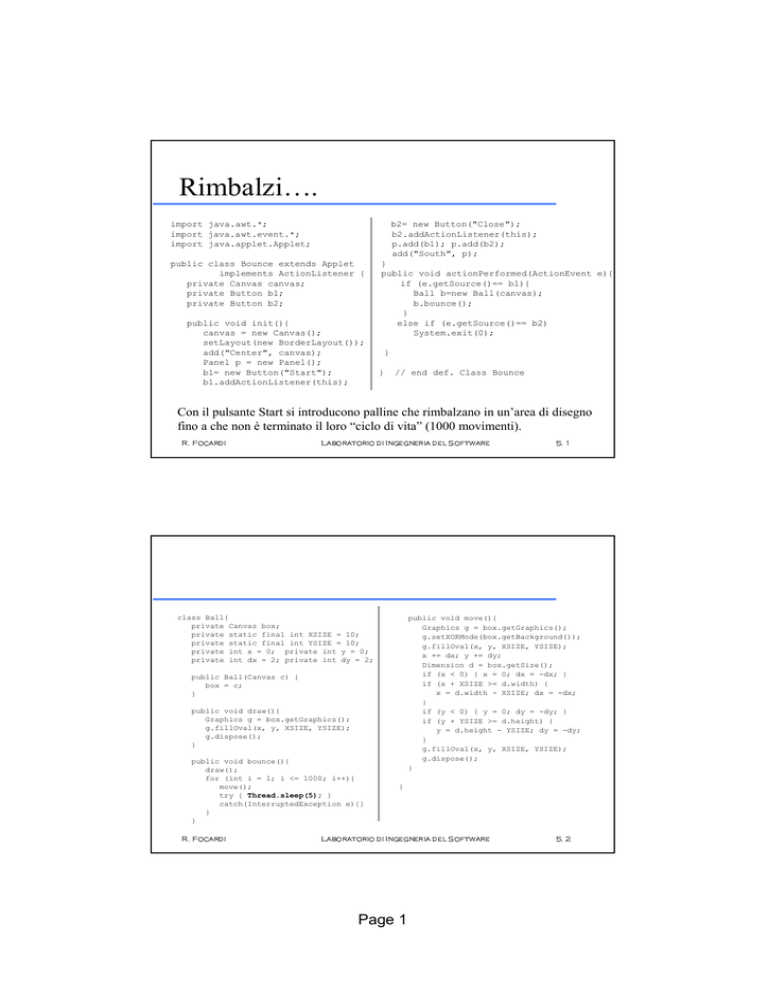
Rimbalzi….
import java.awt.*;
import java.awt.event.*;
import java.applet.Applet;
b2= new Button("Close");
b2.addActionListener(this);
p.add(b1); p.add(b2);
add("South", p);
public class Bounce extends Applet
implements ActionListener {
private Canvas canvas;
private Button b1;
private Button b2;
}
public void actionPerformed(ActionEvent e){
if (e.getSource()== b1){
Ball b=new Ball(canvas);
b.bounce();
}
else if (e.getSource()== b2)
System.exit(0);
public void init(){
canvas = new Canvas();
setLayout(new BorderLayout());
add("Center", canvas);
Panel p = new Panel();
b1= new Button("Start");
b1.addActionListener(this);
}
}
// end def. Class Bounce
Con il pulsante Start si introducono palline che rimbalzano in un’area di disegno
fino a che non è terminato il loro “ciclo di vita” (1000 movimenti).
class Ball{
private Canvas box;
private static final int XSIZE = 10;
private static final int YSIZE = 10;
private int x = 0; private int y = 0;
private int dx = 2; private int dy = 2;
public void draw(){
Graphics g = box.getGraphics();
g.fillOval(x, y, XSIZE, YSIZE);
g.dispose();
}
public void bounce(){
draw();
for (int i = 1; i <= 1000; i++){
move();
try { Thread.sleep(5); }
catch(InterruptedException e){}
}
}
!
"
#
$
%
!
&
"
!
'
"
public void move(){
Graphics g = box.getGraphics();
g.setXORMode(box.getBackground());
g.fillOval(x, y, XSIZE, YSIZE);
x += dx; y += dy;
Dimension d = box.getSize();
if (x < 0) { x = 0; dx = -dx; }
if (x + XSIZE >= d.width) {
x = d.width - XSIZE; dx = -dx;
}
if (y < 0) { y = 0; dy = -dy; }
if (y + YSIZE >= d.height) {
y = d.height - YSIZE; dy = -dy;
}
g.fillOval(x, y, XSIZE, YSIZE);
g.dispose();
}
public Ball(Canvas c) {
box = c;
}
$
}
#
$
(
)
*
+
*
Page 1
)
+
"
$
!
#
+
,
-
.
'
/
!
"
+
0
1
… non funziona!
•
La pallina rimbalza... ma l’applicazione si prende tutte le
risorse fino a che le 1000 iterazioni non sono terminate
Non è possibile interagire con il programma (ad es.
premendo il pulsante “Close”, o facendo partire una
seconda pallina) in nessun modo
•
•
2
Soluzione: usare threads separati, permettendo all’utente
di interagire con il sistema durante l’esecuzione delle
iterazioni, per sospenderla o per dare il via ad altre palline
3
4
5
6
7
8
9
:
;
7
<
5
8
7
=
5
8
:
5
9
:
>
?
@
A
@
?
A
8
:
7
9
A
B
C
5
D
=
E
7
8
A
F
3
G
Threads
•
Multitasking = più programmi/processi lavorano allo
stesso tempo
Multithreading = a livello più basso, più threads (che
possono condividere dati) lavorano allo stesso tempo.
Java, come Modula-3, offre primitive per il
multithreading nel linguaggio (non in librerie!), a
differenza di C e C++ che non supportano multithreading
Java usa multithreading per eseguire garbage collection in
background
•
•
H
•
I
J
K
L
M
N
O
P
Q
M
R
K
N
M
S
K
N
P
K
O
P
T
U
V
W
V
Page 2
U
W
N
P
M
O
W
X
Y
K
Z
S
[
M
N
W
\
I
]
Thread
•
Una trama di esecuzione (thread) è costituita da tre
componenti:
La CPU virtuale
Il codice che la CPU esegue
I dati sui quali la CPU lavora
s
s
s
•
Lo stesso codice può essere condiviso da più threads,
quando eseguono codice di istanze della stessa classe
Gli stessi dati possono essere condivisi da più threads,
quando accedono allo stesso oggetto
In Java, la CPU virtuale è incapsulata in un’istanza della
classe Thread. Quando si costruisce un thread, il codice e
i dati che definiscono il suo contesto sono specificati
dall’oggetto passato al suo costruttore
•
•
^
_
`
a
b
c
d
e
f
g
c
h
a
d
c
i
a
d
f
a
e
f
j
k
l
m
l
k
m
d
f
c
e
m
n
o
a
p
i
q
c
d
m
r
_
r
Creare un thread
public class ProvaThread{
public static void main(String args[]){
Xyz r = new Xyz();
Thread t = new Thread(r);
t.start();
}
class Xyz implements Runnable{
int i;
public void run() {
for (i=0; i<20; i++)
System.out.println(“Ciao”);
}
}
• Il costruttore di Thread prende come parametro un’istanza di Runnable
• L’istanza r di Xyz ha dei suoi dati (ad es. l’intero i)
• Poiché l’oggetto r è passato al costruttore di thread, il thread t “lavorerà”
sui dati di r: mentre t viene eseguito, lavorerà sull’intero i
• Un thread non inizia a girare quando viene creato, ma deve essere fatto
partire chiamando il metodo start()
t
u
v
w
x
y
z
{
|
}
y
~
w
z
y
w
z
|
w
{
|
Page 3
z
|
y
{
w
y
z
u
Esempio (rivisto)
public void actionPerformed(ActionEvent e){
if (e.getSource()== b1){
Ball b=new Ball(canvas);
Thread t= new Thread(b);
t.start();
}
else if (e.getSource()== b2)
System.exit(0);
import java.awt.*;
import java.awt.event.*;
import java.applet.Applet;
public class Bounce extends Applet
implements ActionListener {
private Canvas canvas;
private Button b1;
private Button b2;
}
}
public void init(){
canvas = new Canvas();
setLayout(new BorderLayout());
add("Center", canvas);
Panel p = new Panel();
b1= new Button("Start");
b1.addActionListener(this);
b2= new Button("Close");
b2.addActionListener(this);
p.add(b1); p.add(b2);
add("South", p);
}
class Ball
private
private
private
private
private
// end of Bounce
public Ball(Canvas c) {
box = c;
}
public void draw(){
Graphics g = box.getGraphics();
g.fillOval(x, y, XSIZE, YSIZE);
g.dispose();
}
¡
¢
£
¤
¥
¦
§
¨
©
¥
ª
£
¦
¥
«
£
public void move(){
Graphics g = box.getGraphics();
g.setXORMode(box.getBackground());
g.fillOval(x, y, XSIZE, YSIZE);
x += dx; y += dy;
Dimension d = box.getSize();
if (x < 0) { x = 0; dx = -dx; }
if (x + XSIZE >= d.width) {
x = d.width - XSIZE; dx = -dx;
}
if (y < 0) { y = 0; dy = -dy; }
if (y + YSIZE >= d.height) {
y = d.height - YSIZE; dy = -dy;
}
g.fillOval(x, y, XSIZE, YSIZE);
g.dispose();
}
implements Runnable {
Canvas box;
static final int XSIZE = 10;
static final int YSIZE = 10;
int x = 0; private int y = 0;
int dx = 2; private int dy = 2;
public void run(){
draw();
for (int i = 1; i <= 1000; i++){
move();
try { Thread.sleep(5); }
catch(InterruptedException e){}
}
}
¦
}
¨
£
§
¨
¬
­
®
¯
®
Page 4
­
¯
¦
¨
¥
§
¯
°
±
£
²
«
³
¥
¦
¯
´
¡
µ
Gli stati di un thread
I/O completato
¶
·
¸
¹
º
»
¼
½
¾
¿
»
À
¹
¼
»
Á
¹
¼
¾
¹
½
¾
Â
Ã
Ä
Å
Ä
Ã
Å
¼
¾
»
½
Å
Æ
Ç
¹
È
Á
É
»
¼
Å
Ê
·
Ë
Gli stati di un thread
•
new
quando il thread viene creato con una new, il thread non gira
ancora. Ad es. deve essere allocata della memoria.
ã
•
runnable
quando viene invocato il metodo start(). Un thread runnable
non è detto che giri effettivamente: questo dipende da quando il
sistema operativo glielo consente
ã
•
blocked
il thread è bloccato in tre modi:
ã
- nella wait-pool di un oggetto
- nella lock-pool di un oggetto
- a causa di uno sleep() o join().
•
dead
quando il metodo run termina
Ì
ã
Í
Î
Ï
Ð
Ñ
Ò
Ó
Ô
Õ
Ñ
Ö
Ï
Ò
Ñ
×
Ï
Ò
Ô
Ï
Ó
Ô
Ø
Ù
Ú
Û
Ú
Page 5
Ù
Û
Ò
Ô
Ñ
Ó
Û
Ü
Ý
Ï
Þ
×
ß
Ñ
Ò
Û
à
Í
á
â
Priorità
•
Ogni thread ha una priorità
MIN_PRIORITY (posta a 1 nella classe Thread)
MAX_PRIORITY(posta a 10 nella classe Thread)
NORM_PRIORITY (posta a 5 nella classe Thread)
ú
ú
ú
•
Scheduling:
Quando lo scheduler decide quale sarà il nuovo thread a girare,
selezionerà il thread con massima priorità, e continuerà ad
eseguirlo fino a che esso
• “lascia la precedenza” col metodo yield()
• oppure cessa di essere in stato “runnable”
• oppure è rimpiazzato da un altro thread la cui priorità è
divenuta maggiore
• oppure è rimpiazzato da un altro thread con la stessa priorità
se il sistema supporta time-slicing
ú
ä
å
æ
ç
è
é
ê
ë
ì
í
é
î
ç
ê
é
ï
ç
ê
ì
ç
ë
ì
ð
ñ
ò
ó
ò
ñ
ó
ê
ì
é
ë
ó
ô
õ
ç
ö
ï
÷
é
ê
ó
ø
å
ù
ù
Esempio
import java.awt.*;
import java.awt.event.*;
import java.applet.Applet;
p.add(b1); p.add(b2); p.add(b3);
add("South", p);
}
public class Bounce extends Applet
implements ActionListener {
private Canvas canvas;
private Button b1;
private Button b2;
private Button b3;
public void actionPerformed(ActionEvent e){
if (e.getSource()== b1){
Ball b=new Ball(canvas);
Thread t = new Thread(b);
t.setPriority(Thread.MIN_PRIORITY);
t.start();
}
else if (e.getSource()== b2){
Ball b=new Ball(canvas);
Thread t = new Thread(b)
t.setPriority(Thread.MAX_PRIORITY);
t.start();
}
else if (e.getSource()== b3)
System.exit(0);
}
public void init(){
canvas = new Canvas();
setLayout(new BorderLayout());
add("Center", canvas);
Panel p = new Panel();
b1= new Button("Start");
b1.addActionListener(this);
b2= new Button("Quick");
b2.addActionListener(this);
b3= new Button("Close");
b3.addActionListener(this);
}
// la classe Ball è uguale a prima
La pallina “veloce” corre di più, e se ce ne sono molte, di veloci, quelle normali
si fermano finché queste non sono in “sleep”.
ä
å
æ
ç
è
é
ê
ë
ì
í
é
î
ç
ê
é
ï
ç
ê
ì
ç
ë
ì
ð
ñ
ò
ó
ò
Page 6
ñ
ó
ê
ì
é
ë
ó
ô
õ
ç
ö
ï
÷
é
ê
ó
ø
å
ù
û
sleep() - yield()
•
Il codice di un thread può contenere una chiamata al comando
Thread.sleep(k), che forza il thread a sospendere la propria
esecuzione per almeno k millisecondi
•
Poiché non è detto che i threads siano time-sliced, è necessario
assicurarsi che gli altri threads abbiano la possibilità di continuare
l’esecuzione. Questo può essere ottenuto chiamando sleep() a
intervalli regolari
•
Il metodo yield() pone il thread corrente nella lista dei thread
“runnable” e dà la possibilità ad un altro thread della stessa priorità di
essere eseguito. Se nessun altro thread della stessa priorità è runnable,
yield() non ha nessun effetto.
ü
ý
þ
ÿ
ÿ
ÿ
ÿ
ÿ
ý
Esempio
class Trama extends Thread{
private int id;
static int index;
String [] memo;
import java.applet.Applet;
import java.awt.*;
public class ProvaYield extends Applet{
private Trama t1,t2;
private TextArea output;
private String [] memo;
public Trama(int n, String [] m){
id = n;
memo = m;
setPriority(Thread.MAX_PRIORITY);
}
public void init(){
output=new TextArea(10,30);
add(output);
public void run(){
for (int i=0; i<20; i++){
memo[index++] = "Thread " +
id +" prima di yield() \n";
yield();
memo[index++] = "Thread " +
id + " dopo yield() \n";
}
}
Thread 1 prima di yield()
}
Thread 2 prima di yield()
Thread 1 dopo yield()
Thread 1 prima di yield()
Thread 2 dopo yield()
Thread 2 prima di yield()
Thread 1 dopo yield()
Thread 1 prima di yield()
Thread 2 dopo yield()
Thread 2 prima di yield()
…..
}
public void start(){
memo = new String[80];
t1 = new Trama(1,memo);
t2 = new Trama(2,memo);
t1.start(); t2.start();
try {t1.join(); t2.join(); }
catch(InterruptedException e) {}
for (int i=0; i<80; i++){
output.append(memo[i]);
}
}
}
ü
ý
þ
ÿ
ÿ
ÿ
ÿ
Page 7
ÿ
ý
isAlive() - join()
•
Il metodo isAlive() è usato per determinare se un thread
è ancora disponibile. “Alive” non significa che il thread è
“runnable”: restituisce true se il thread è iniziato ma non è
ancora nello stato “dead”.
Il metodo join() forza il metodo corrente ad aspettare
finché il thread sul quale il join() è chiamato non
termina
join può essere anche chiamato con un valore di timeout
in millisecondi: t.join(k) sospende il thread corrente
per k millisecondi o finché il thread t non termina
•
•
!
"
#
"
!
#
#
$
%
&
'
#
(
)
(
Sincronizzazione: esempio
class BankTest{
public static void main(String[] args){
Bank b = new Bank();
int i;
for (i = 1; i <= Bank.NACCOUNTS; i++){
Transaz r = new Transaz(b, i);
Thread t = new Thread(r);
t.start();
}
}
}
public void transfer
(int from,int to,int amount){
while (accounts[from] < amount){
try { Thread.sleep(5); }
catch(InterruptedException e) {}
}
accounts[from] -= amount;
accounts[to] += amount;
ntransacts++;
if (ntransacts % 5000 == 0) test();
}
class Bank{
public static final int IN_BALANCE = 10000;
public static final int NACCOUNTS = 80;
private long[] accounts;
private int ntransacts;
public void test(){
int i;
long sum = 0;
for (i = 0; i < NACCOUNTS; i++)
sum += accounts[i];
System.out.println("Transactions:"
+ ntransacts + " Sum: " + sum);
public Bank(){
accounts = new long[NACCOUNTS];
int i;
for (i = 0; i < NACCOUNTS; i++)
accounts[i] = IN_BALANCE;
ntransacts = 0;
test();
}
}
}
!
"
#
"
Page 8
!
#
#
$
%
&
'
#
(
)
*
output
class Transaz implements Runnable {
iniziale
20000
700000
900000
1000000
1500000
2000000
2500000
4000000
private Bank bank;
private int from;
public Transaz (Bank b, int i){
from = i - 1;
bank = b;
}
public void run(){
while (true){
int to = (int)((Bank.NACCOUNTS - 1) * Math.random());
if (to == from) to = (to + 1) % Bank.NACCOUNTS;
int amount = 1 + (int)(Bank.IN_BALANCE * Math.random()) / 2;
bank.transfer(from, to, amount);
try { Thread.sleep(1); }
catch(InterruptedException e) {}
}
}
800000
798538
799926
790436
788144
786120
788577
785879
783584
}
+
,
-
.
/
0
1
2
3
4
0
5
.
1
0
6
.
1
3
.
2
3
7
8
9
:
9
8
:
1
3
0
2
:
;
<
.
=
6
>
0
1
:
?
,
@
A
?
,
@
E
synchronized
•
Quando due o più threads accedono alle stesse
risorse, si possono creare problemi di
sincronizzazione
Il qualificatore di metodo synchronized
garantisce che il metodo termini prima che un
altro thread possa utilizzare lo stesso oggetto
•
+
public synchronized void transfer (int from,int to,int amount){
while (accounts[from] < amount){
try { Thread.sleep(5); }
catch(InterruptedException e) {}
}
accounts[from] -= amount;
accounts[to] += amount;
ntransacts++;
if (ntransacts % 5000 == 0) test();
}
,
-
.
B
C
1
2
3
4
C
5
.
1
C
6
.
1
3
.
2
3
D
8
9
:
9
Page 9
8
:
1
3
C
2
:
;
<
.
=
6
>
C
1
:
Lock flag - Synchronized
•
Ogni oggetto ha un “lock flag” associato. Il modificatore
synchronized permette di interagire con questo flag, che
consente accesso esclusivo all’oggetto.
Quando un thread deve eseguire un metodo synchronized,
esamina l’oggetto passato come argomento e cerca di
ottenere l’accesso esclusivo dell’oggetto prima di
continuare
Quando il thread ha terminato l’esecuzione del metodo, il
lock flag viene rilasciato automaticamente
•
•
F
G
H
I
J
K
L
M
N
O
K
P
I
L
K
Q
I
L
N
I
M
N
R
S
T
U
T
S
U
L
N
K
M
U
V
W
I
X
Q
Y
K
L
U
Z
G
Z
G
[
\
Monitors
•
Ma cosa succede nell’esempio precedente se il conto non
contiene abbastanza denaro? Quel thread ha uso esclusivo
dell’oggetto di classe Bank! Nessun altro thread può fare
depositi...
Quando si crea un oggetto con metodi sinchronyzed, Java
associa a quell’oggetto (detto monitor) una coda dei
threads che aspettano di poter accedere all’oggetto.
•
Thread 2 Thread 3 Thread 4
Bank
F
Thread 1
G
H
I
J
K
L
M
N
O
K
P
I
L
K
Q
I
L
N
I
M
N
R
S
T
U
T
S
Page 10
U
L
N
K
M
U
V
W
I
X
Q
Y
K
L
U
]
^
wait - notify
•
Se un thread “runnable” chiama wait(), il thread entra
nella coda di attesa associata all’oggetto particolare sul
quale è stato chiamato wait().
Il primo thread nella coda di attesa di un oggetto diventa
“runnable” appena un altro thread associato allo stesso
oggetto chiama notify() o notifyAll().
•
_
`
a
b
c
d
e
f
g
h
d
i
b
e
d
j
b
e
g
b
f
g
k
l
m
n
m
l
n
e
g
d
f
n
o
p
b
q
j
r
d
e
n
s
`
t
u
Uso di wait e notify
_
public synchronized void transfer (int from,int to,int amount){
while (accounts[from] < amount){
try { wait(); }
catch(InterruptedException e) {}
}
accounts[from] -= amount;
accounts[to] += amount;
ntransacts++;
if (ntransacts % 5000 == 0) test();
notify();
}
`
a
b
c
d
e
f
g
h
d
i
b
e
d
j
b
e
g
b
f
g
k
l
m
n
m
l
Page 11
n
e
g
d
f
n
o
p
b
q
j
r
d
e
n
s
`
t
t
Tipicamente…
•
Se due o più threads modificano un oggetto, dichiarare
synchronized il metodo che realizza le modifiche
Se un thread deve aspettare che lo stato di un oggetto
cambi, deve farlo dentro l’oggetto, non fuori, chiamando
•
wait()
•
v
Ogniqualvolta un metodo modifichi lo stato dell’oggetto,
deve chiamare notify(), per dare una chance ai threads
in lista di attesa di vedere se le condizioni dell’oggetto
sono cambiate.
w
x
y
z
{
|
}
~
{
y
|
{
y
|
~
y
}
~
|
~
{
}
y
{
|
w
w
La classe java.lang.Thread
•
Thread(): costruisce un nuovo thread
•
void run(): questo metodo deve essere overridden e deve
contenere il codice che deve essere eseguito nel thread
•
void start(): inizia il thread, e invoca il metodo run()
•
static void sleep(long millisec): mette “a
dormire” il thread per un numero di millisecondi fissato. Osservare
che questo metodo è statico
void interrupt(): manda al thread una richiesta di
•
interruzione
static boolean interrupted(): domanda al
•
thread se è stato interrotto o no
v
w
x
y
z
{
|
}
~
{
y
|
{
y
|
~
y
}
~
Page 12
|
~
{
}
y
{
|
extends Thread
•
Una alternativa all’implementazione
dell’interfaccia Runnable è utilizzare
direttamente un oggetto di una classe che estende
Threads
•
Anche in questo caso è essenziale fare
l’overriding del metodo run()
¡
¢
£
¢
Démoni
•
Un démone è un thread che non ha altro ruolo che servire
altri threads
Quando non rimane vivo nessun thread (che non sia un
démone), anche i démoni muoiono. Questo accade, ad
esempio, quando l’applicazione termina: in tale caso tutti i
threads demoni terminano automaticamente;
•
•
void setDaemon(boolean on)
questo metodo deve essere chiamato prima dello start del
thread
Page 13
¡
¢
£
¤
Costruire timers usando threads
import java.awt.*;
import java.util.*;
import java.applet.Applet;
class Timer extends Thread {
private Timed target;
private int interval;
public class TimerTest extends Applet {
public void init(){
add(new ClockCanvas("Venezia", 0));
add(new ClockCanvas("New York", 6));
}
}
public Timer(Timed t, int i) {
target = t;
interval = i;
setDaemon(true);
}
interface Timed{
public void tick(Timer t);
}
public void run(){
while (true){
try { sleep(interval); }
catch(InterruptedException e){}
target.tick(this);
}
}
}
¥
¦
§
¨
©
ª
«
¬
­
®
ª
¯
¨
«
ª
°
¨
«
­
¨
¬
­
±
²
³
´
³
²
´
«
­
ª
¬
´
µ
¶
¨
·
°
¸
ª
«
´
¹
¦
º
»
class ClockCanvas extends Canvas implements Timed{
private int seconds = 0;
private String city;
private int offset;
private final int LOCAL = 0;
public ClockCanvas(String c, int off){
city = c; offset = off;
new Timer(this, 1000).start();
resize(125, 125);
}
public void paint(Graphics g){
g.drawOval(0, 0, 100, 100);
double hourAngle
= 2 * Math.PI * (seconds - 3 * 60 * 60) / (12 * 60 * 60);
double minuteAngle = 2 * Math.PI * (seconds - 15 * 60) / (60 * 60);
double secondAngle = 2 * Math.PI * (seconds - 15) / 60;
g.drawLine(50,50,50 + (int)(30*Math.cos(hourAngle)),50 + (int)(30*Math.sin(hourAngle)));
g.drawLine(50,50,50 + (int)(40*Math.cos(minuteAngle)),50 + (int)(40*Math.sin(minuteAngle)));
g.drawLine(50,50,50 + (int)(45*Math.cos(secondAngle)),50 + (int)(45*Math.sin(secondAngle)));
g.drawString(city, 0, 115);
}
public void tick(Timer t){
Date d = new Date();
seconds = (d.getHours() - LOCAL + offset)* 60 * 60 + d.getMinutes() * 60 + d.getSeconds();
repaint();
}
¥
¦
§
¨
©
ª
«
¬
­
®
ª
¯
¨
«
ª
°
¨
«
­
¨
¬
­
±
²
³
´
³
²
}
Page 14
´
«
­
ª
¬
´
µ
¶
¨
·
°
¸
ª
«
´
¹
¦
º
¼


